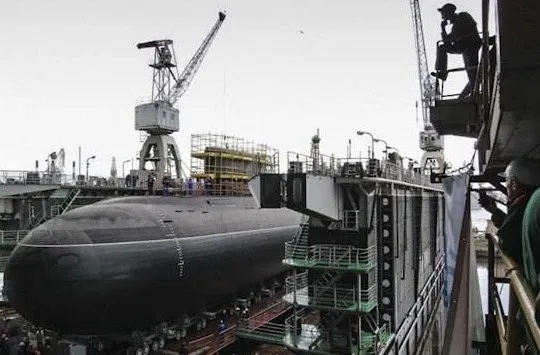After the B-603 Volkhov, the Russian Pacific Fleet will be strengthened by another type of Project 636.3 Vashavyanka Class submarine or “Kilo Class Next Generation”, namely ‘Yakutsk’, which was launched on October 11, 2024 by the Admiralty shipyard (United Shipbuilding Corporation) in St. Petersburg.
In addition to being directed to the Pacific Fleet, some of the Vashavyanka Class that have been launched are also intended for the Baltic Sea Fleet, including Petropavlovsk-Kamchatsky, Volkhov, Magadan, Ufa, and Mozhaisk, all of which were built by Admiralty Shipyards JSC.
Yakutsk has a displacement of 4,000 tons and is capable of speeding up to 20 knots when diving. With the ability to dive to a depth of 300 meters, the Vashavyanka Class can sail continuously (without refueling) for 45 days and sail as far as 12,000 km powered by two diesel engines and an electric motor. One of its prominent features is its very low acoustic signature, earning it the nickname “black hole” due to its ability to avoid sonar detection.
The Vashavyanka class is designed to be quieter than the Kilo Class, one of which is by adopting a special anechoic coating applied to the outer hull surface to reduce noise coming from its interior. The main generator of this submarine is also isolated using rubber to prevent vibrations. The shipyard even dares to boast that this is the submarine with the best level of silence in the world.
With all its advantages, the Vashavyanka class does not adopt Air-Independent Propulsion (AIP) technology, which Russia says can actually reduce the stealth capabilities of a submarine.
The Vashavyanka class j is equipped with six torpedo launcher tubes, while the weapons package carried in addition to 533 mm torpedoes, there are also Kalibr anti-ship missiles (3M-54 and 3M-541) to attack targets on the surface, then there are 3M-14 cruise missiles to attack land. Its sonar and navigation systems are sophisticated, providing high precision in both offensive and defensive operations.
The submarine is designed for multi-role missions, including anti-submarine warfare, intelligence gathering, and reconnaissance. In addition, its endurance allows it to remain submerged for long periods, making it a key asset in coastal defense and strategic deterrence for the Russian Navy.
Following its launch on October 11, Yakutsk will undergo a series of rigorous tests and sea trials before it can be officially commissioned into the Russian Navy.
The submarine will undergo a series of sea trials to evaluate its propulsion system, acoustic signature, and overall performance under various operational conditions. Engineers will test its ability to operate quietly, a key feature of the Varshavyanka class, as well as its navigation, sonar, and combat systems. These trials ensure that Yakutsk meets all technical specifications and can effectively carry out its intended missions, from anti-submarine warfare to intelligence gathering.
Following the sea trials, Yakutsk will participate in live-fire exercises to verify its weapons systems, including torpedoes and Kalibr cruise missiles. The crew will be trained and evaluated on operational readiness, emergency procedures and mission execution, to ensure the submarine’s full integration into active service.
Beyond combat operations, Yakutsk is also designed for broader strategic missions, such as patrolling critical maritime zones and protecting vital sea routes. Its ability to remain submerged for extended periods of time allows for long-range patrols, including in the Pacific, where it will likely support Russian efforts to maintain influence and monitor NATO or US naval activity.
The submarine can support covert missions or deploy underwater drones for intelligence and surveillance tasks. Its combination of firepower, stealth and operational range ensures Yakutsk will be a key asset in Russia’s modern naval strategy.



